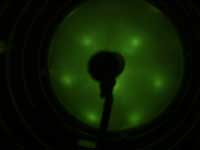Low Energy Electron Diffraction (LEED)

LEED pattern of a Zn-ZnO surface obtained in our lab.
LEED is one of the most simple standard surface chemistry techniques.
However, the theory of electron scattering is difficult to understand (in the beginning).
Briefly, LEED is used to check the cleanliness and the quality of the crystallographic structure of surfaces. LEED can also be used to determine the adsorption structure of adsorbates (particles adsorbed on the catalyst surface) and the coverage (surface particle density) of adsorbates.
In doing so, an electron beam (like the one in old TV screens) will be directed against the surface. The backscattered electrons will then be collected on a phosphor screen. Various different pattern can be observed depending on the crystallographic structure of the sample. Loosely speaking, the LEED pattern is a superposition of electron waves like the interference of water waves. Mathematically the LEED pattern is related to a Fourier transformation of the crystal lattice, i.e., it is related to the so-called reciprocal lattice. Interested in details? Come to the surface chemistry class.
